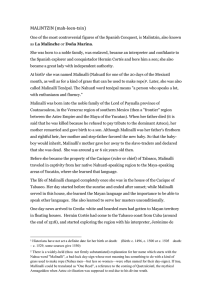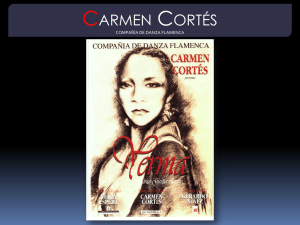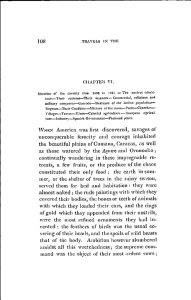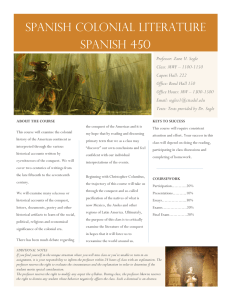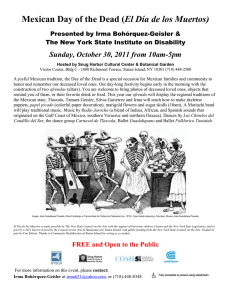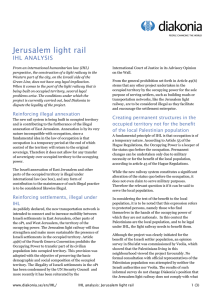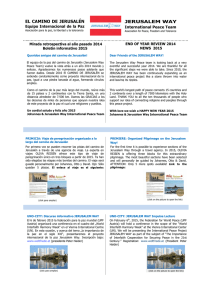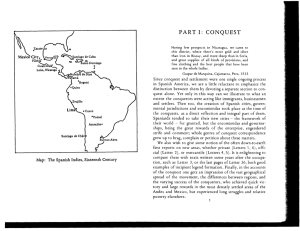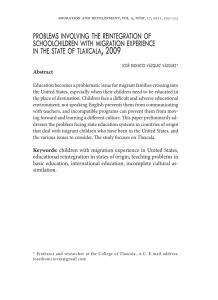Diaz sf THE TLAXCALANS CONQUER JERUSALEM IN 1539
Anuncio
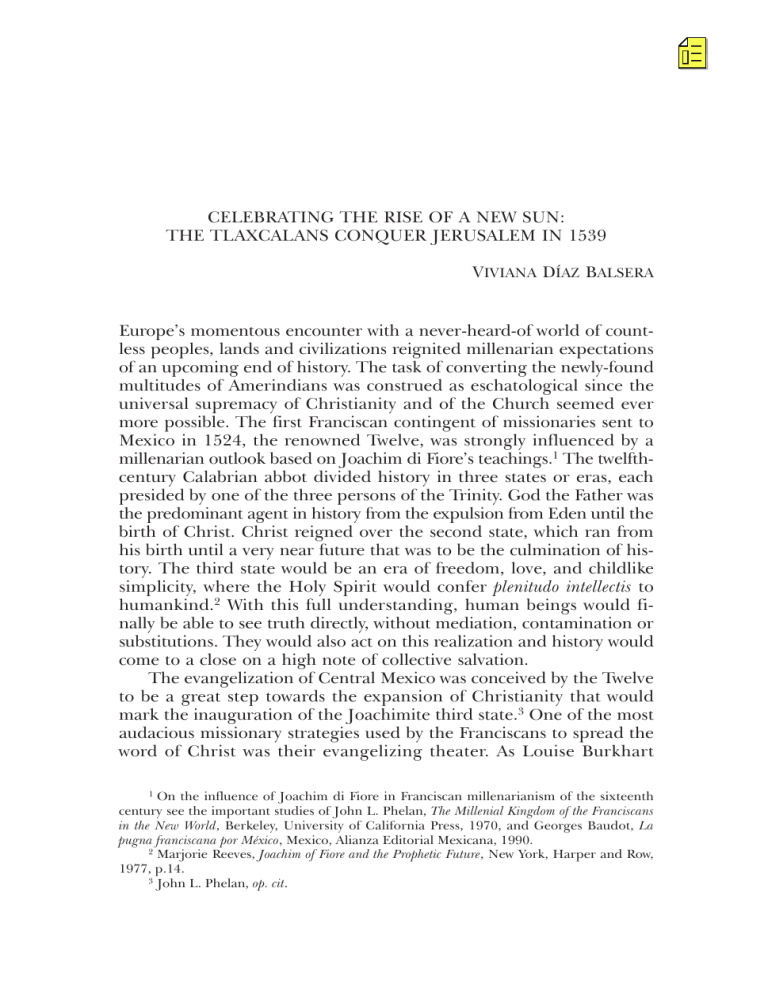
CELEBRATING THE RISE OF A NEW SUN: THE TLAXCALANS CONQUER JERUSALEM IN 1539 Viviana Díaz Balsera Europe’s momentous encounter with a never-heard-of world of countless peoples, lands and civilizations reignited millenarian expectations of an upcoming end of history. The task of converting the newly-found multitudes of Amerindians was construed as eschatological since the universal supremacy of Christianity and of the Church seemed ever more possible. The first Franciscan contingent of missionaries sent to Mexico in 1524, the renowned Twelve, was strongly influenced by a millenarian outlook based on Joachim di Fiore’s teachings. The twelfthcentury Calabrian abbot divided history in three states or eras, each presided by one of the three persons of the Trinity. God the Father was the predominant agent in history from the expulsion from Eden until the birth of Christ. Christ reigned over the second state, which ran from his birth until a very near future that was to be the culmination of history. The third state would be an era of freedom, love, and childlike simplicity, where the Holy Spirit would confer plenitudo intellectis to humankind. With this full understanding, human beings would finally be able to see truth directly, without mediation, contamination or substitutions. They would also act on this realization and history would come to a close on a high note of collective salvation. The evangelization of Central Mexico was conceived by the Twelve to be a great step towards the expansion of Christianity that would mark the inauguration of the Joachimite third state. One of the most audacious missionary strategies used by the Franciscans to spread the word of Christ was their evangelizing theater. As Louise Burkhart On the influence of Joachim di Fiore in Franciscan millenarianism of the sixteenth century see the important studies of John L. Phelan, The Millenial Kingdom of the Franciscans in the New World, Berkeley, University of California Press, 1970, and Georges Baudot, La pugna franciscana por México, Mexico, Alianza Editorial Mexicana, 1990. Marjorie Reeves, Joachim of Fiore and the Prophetic Future, New York, Harper and Row, 1977, p.14. John L. Phelan, op. cit. 312 Viviana Díaz Balsera notes, the friars possibly concluded that in order to attract large masses of Nahuas to Christianity “the most effective —indeed, the only— way [...] was through the use of song, dance, plays, processions, and their accompanying pageantry and paraphernalia”. The 1539 performance in Tlaxcala of The Conquest of Jerusalem was perhaps the most memorable episode of this evangelizing theater in the sixteenth century. A hybrid of ritual, dramatic art, procession and pageantry, it served the purpose of celebrating, ratifying and consolidating the historical triumph of Christianity in the Mexican highlands while imagining its final victory in the world. From a Western-European perspective, it is in the contexts of a millenarian hope or expectancy and of theater as a vehicle for the expansion of Christianity where the study of the splendid Tlaxcalan auto should be located. I propose that one can see actual fulfillment of Franciscan millenarian desire in the content of this play, in the epic, all-embracing scale in which it was performed, and in the historical mass baptisms with which it concluded. I propose also that Cortés’s role in the play as Sultan of the Turks —which has intrigued so many of its commentators— is instrumental to the millenarian outcome of the piece. Literary critics and historians have rightly concluded that in this play we can discern the Tlaxcalans attempting to enhance their history, status and privileges by displaying their masterful appropriation of prestigious Spanish colonial discourses as well as their brilliant management of performance space. I further suggest however that the millenarian themes exhibited in the exemplary The Conquest of Jerusalem were congruent with the legendary lore of the conquest of Tlaxcala as evinced by the patriotic Lienzo de Tlaxcala, by the Tlaxcala Codex, and by the historical work of Thadeo de Niza of 1548. These millenarian themes were taken to an even higher level of imagined historical reconstruction in the 1580s by Diego Muñoz Camargo’s Historia de Tlaxcala and the Descripción de la ciudad. Finally, I attempt to show that some themes of the legendary lore may have harked back to preHispanic historiographical conventions, and can be appreciated in other pictorial documents such as the Mapa de Cuauhtlantzinco, the Louise Burkhart, Holy Wednesday: A Nahua Drama from Early Colonial Mexico, Philadelphia, University of Pennsylvania Press, 1996, p. 43. See on this subject Roland Baumann, “Tlaxcalan Expression of Autonomy and Religious Drama in Sixteenth Century”. Journal of Latin American Lore, 1987, v. 13, p. 139-153; Stephanie Wood, Transcending Conquest. Nahua Views of Spanish Colonial Mexico, Norman, University of Oklahoma Press, 2003, p. 96, 98. Charles Gibson, Tlaxcala in the Sixteenth Century, Stanford, Stanford University Press, 1952, p. 146; Stephanie Wood, op. cit., p. 84-94. Stephanie Wood, op. cit., p. 85-106. CELEBRATING THE RISE OF A NEW SUN 313 Lienzo of Quauhquechollan, and the Mapa de Cuauhtinchan n. 2. Thus, while splendidly enacting a European (namely Franciscan) millenarian vision of the future, the Tlaxcalan The Conquest of Jerusalem also contributed to the eventual record of the recent, colonial history of Central Mexico both from the perspectives of its shifting indigenous present and of its ineradicable past. In his History of the Indians of New Spain, finished approximately in 1541, fray Toribio de Benavente or Motolinía enthusiastically narrated how two years earlier, during the feast of Corpus Christi, the Tlaxcalans staged The Conquest of Jerusalem to celebrate a peace treaty between the kings of Spain and France. In his letter to the Minister of the Province of the Holy Gospel in Mexico included in the History, Motolinía writes: The news [of the treaty of Cambray in 1538] reached this land a few days before Lent. The Tlaxcaltecas wanted first to see what the Spaniards and Mexicans would do. When they saw that they arranged and represented the conquest of Rhodes, the Tlaxcaltecas decided to stage the conquest of Jerusalem, a prediction which, we pray, God may fulfill in our day. To make the play more solemn, the Indians of Tlaxcala agreed to postpone it to the feast of the Corpus Christi, the day which they celebrated with great enthusiasm, as I shall now relate. If the Mexicans had reached back to the European medieval past to search for a story of the triumph of Christianity over infidels that they could stage, the Tlaxcalans, always in competition with their old rivals, chose to look forward, as Motolinía points out in passing. We should recall that the Holy City had been re-conquered by the Crusaders in 1099 and then lost to the Muslims again in 1187. The Egyptian sultan Malek-el Khamil delivered Jerusalem to Emperor Frederick II of Hohenstaufen in 1229 but the Crusaders were defeated once again in 1244. Throughout the Middle Ages, in the Christian spiritual interpretation of the physical world according to the Scriptures, Jerusalem appeared in the mappa mundi as the center of nations and of the universe since it was considered to be the Centre of Faith.10 For the millenarian, eschatological imagination, Jerusalem would be the earthly city where Christ and his chosen people would live in peace, with the Florine G. L. Asselbergs, Conquered Conquistadors. The Lienzo of Quauhquechollan: A Nahua Vision of the Conquest of Guatemala, Leiden, cnws Publications, 2004, p. 190-195. Motolinía, History of the Indians of New Spain, trans. by Francis Borgia Steck, Washington, Academy of American Franciscan History, 1951, p. 160. 10 Valerie Flint, The Imaginative Landscape of Christopher Columbus, Princeton, Princeton University Press, 1992, p. 8; Margarita Zamora, Reading Columbus, Berkeley, University of California Press, 1993, p. 103. 314 Viviana Díaz Balsera Devil imprisoned in the abyss for a thousand years until the Final Judgment.11 The deliverance of the Holy City and the “cleansing” of its Muslim captors would then herald the Second Coming. It is relevant to point out in this context that Christopher Columbus, the Christum Ferens, the chosen one who alleged in the letter of his third voyage that he had sailed near Paradise claimed that he planned to liberate Jerusalem with the unimaginable riches that he would bring back from the East.12 Columbus believed that the world would come to an end approximately in 1657.13 In the auto The Conquest of Jerusalem, then, the Tlaxcalans represented the longed-for event that would mark the beginning of the final era of human history in which peace, justice and abundance —as well as Christianity— would prevail at last on earth, and not only in the heavenly afterlife. The reader of Motolinía’s account is first struck by the Tlaxcalans’ willingness to spare no effort in order to set up the enormous stage for the city of Jerusalem needed for the play.14 Five towers were constructed in the open space that would become the plaza or central square of the new provincial capital city of Tlaxcala. Buildings that had already the height of an estado or approximately seven feet were leveled off in order to make room for Jerusalem. Othon Arróniz has rightly suggested that this “inordinate effort” was motivated by the desire to compete with the Mexicans’ impressive representation of The Conquest of Rhodes alluded to above.15 Ironically then, an indigenous struggle for status and prestige ongoing since pre-Hispanic times underlay the dramatic rendering of the Christian imagination of the coming end of history. On the outskirts of the Tlaxcalan Jerusalem five camps were erected where the forces fighting for Christianity would lodge when combating the infidels. The bread or host, which if consecrated by a priest should contain the actual presence of Christ, was stationed in a higher platform “in order that all the festivities might be enacted before 11 Pauline M. Watts, “Prophecy and Discovery: On the Spiritual Origins of Christopher Columbus’s ‘Enterprise of the Indies’”, American Historical Review, 1985, v. 90, p. 73-102; Frederic J Baumgartner, Longing for the End. A History of Millennialism in Western Civilization, New York, St. Martin’s Press, 1999, p. 63; Frank Graziano, The Millenial New World, Oxford, Oxford University Press, 1999, p. 6-7. 12 Frederic J. Baumgartner, op. cit., p. 119-120; Frank Graziano, op. cit., p. 28. 13 Pauline M. Watts, op. cit., p. 96; Frederic Baumgartner, op. cit., p. 120. 14 My analysis of the play is based only on Motolinía’s account of the performance. Still, even from Motolinía’s inevitably subjective reconstruction of the performance much can be conjectured about what went on, supported by what is known about the ideological and historical contexts of the play. 15 Othón Arróniz, op. cit, p. 65. CELEBRATING THE RISE OF A NEW SUN 315 the Most Holy Sacrament”,16 as if it were actually alive and could see what was going on in its service. Tlaxcalan actors impersonating cardinals, bishops and even the Pope sat next to the Holy Sacrament during the performance. Some of these characters were both spectators of the play and participants in its dramatic action. Other indigenous actors, presumably nobles or pipiltin, impersonated important Spanish colonial figures such as Antonio Pimentel and Don Antonio de Mendoza, then Viceroy of New Spain. These figures in turn led the armies of Spain and New Spain, respectively. As many critics have pointed out, perhaps the most enigmatic of these double impersonations was that of the impersonated Hernán Cortés, who played the role of the infidel Sultan of the Turks. I will discuss this admittedly intriguing issue in more detail below. The Spanish army was represented as composed of soldiers from all provinces of Spain as well as by Germans, Romans and Italians. Motolinía points out that all the European soldiers were dressed alike “because, not having seen European soldiers, the Indians do not know how each group dresses, and hence they are not wont to differentiate.”17 This comment indicates that the Tlaxcalans were in charge of the mise-en-scene of the play.18 At the very end of the piece, hundreds of indigenous actors playing the part of infidel Turks actually received baptism from a priest ordered by the impersonated Pope to administer the sacrament.19 What is of interest here is the great complexity of the figurative and referential levels that were present simultaneously in the play. Spatial, temporal and semantic boundaries were dimmed as audience and actors merged at several points in sophisticated instances of a play within a play.20 The impersonated characters playing historically unlikely roles 16 Motolinía, History of the Indians of New Spain, trans. by Francis Borgia Steck, Washington, Academy of American Franciscan History, 1951, p. 160. 17 Motolinía, op. cit., p. 160. 18 In his article “¿Insertos en la ‘historia sagrada’? Respuesta y reacomodo de los mesoamericanos”, Estudios de Cultural Náhuatl, v. 26, 1996, p. 161, Miguel León-Portilla points out that according to the missionary chroniclers, the Nahuas were usually the ones in charge of dealing with this aspect of the performance. James Lockhart posits in The Nahuas after the Conquest, Stanford, Stanford University Press, 1992, p. 403 and 407 that the intervention of the friars in the evangelization theater was limited to choosing themes and writing something down in Spanish that the Nahua aides would then translate into Nahuatl and adapt to the stage. Indeed, in the case of The Conquest of Jerusalem, the theme must have originated with the friars as it was clearly not part of the Nahua cultural horizon. Motolinía’s comment about the Tlaxcalans’ misrepresentation of the European armies’ dress supports the hypothesis that although the friars may have selected the themes, the Nahuas themselves, most likely the pipiltin, were the ones in charge of producing the plays and performing in them, a thesis also expounded by Louise Burkhart, op. cit., p. 47-48. 19 Motolinía, op. cit., p. 166. 20 Othón Arróniz, op. cit., p. 71. 316 Viviana Díaz Balsera such as Cortés having the part of the Turkish Sultan produced a dedoublement, or play of mirrors that thickened the illusionistic effect of the dramatic piece. In the end, however, the auto dissolved into actual historical time with the administration of baptism to hundreds of actors as performance culminated in ritual. All these elements blurred the boundaries of reality and dramatic illusion more radically than in European medieval and Renaissance religious drama.21 In the tradition of the Corpus Christi celebrations in Spain, for instance, just like in The Conquest of Jerusalem, an auto or religious play would be performed in the public square. But there was still a distinction between historical and dramatic time. It could be argued that the consecrated host in the festivity of Corpus Christi was also taken in procession and that the symbolic power of the promenading sacred would stay on, cleansing the historical, worldly realm of the streets. However, this purifying effect of the sacred did not achieve so distinctive and permanent a transformation as in the case of the multitudes of indigenous actors impersonating infidels in the public square and receiving the sacrament of Baptism at the end of the representation. For once the actors were ritually baptized, they became part of the Christian community for the rest of their lives as their own selves, apart from the representation. And yet, the boundaries between dramatic, ritual and historical time in the Tlaxcalan Conquest of Jerusalem were not as blurred as in pre-Hispanic calendric rituals. In these rituals, sacred narratives were also played out with human actors impersonating specific gods. But when an individual wore the special regalia of a deity, its sacred force was conjured and came to inhabit or cohabit with the human “actor”. The impersonating individual then became an ixiptla or image of divinity, and the distance between his own self as an actor and that of the god dissolved.22 Moreover, in most calendrical feasts this intimate proximity between the human impersonator and the deity was never reversed because the ixiptla was sacrificed as part of the sacred time opened up by the ritual. The person died as an ixiptla or actual image of the god, not as a human, and thus his or her “individuality [was]… permanently eliminated”.23 The close relationship established by the ixiptla between the human and the divine and its irreversibility pro21 This is the case even if medieval dramatic activity should be taken to include not only plays, but also street performances, pageants, processions, mimes and representations in the public square, as Charlotte Stern has suggested in “The Medieval Theater: Replacing the Darwinian Model”, Corónica, v. 24, 1996, p. 166-178. 22 Inga Clendinnen, Aztecs, an Interpretation, Cambridge, Cambridge University Press, 1991, p. 248-253. 23 Louise Burkhart, op. cit., p. 44. CELEBRATING THE RISE OF A NEW SUN 317 duced by the materiality of death in the calendrical ritual was never posited in European medieval or Renaissance drama. In The Conquest of Jerusalem, however, because of its unique, hybrid blend of theater with ritual, representation and reality were blurred across both Christian European and Nahua traditions. In the Tlaxcalan performance, the individuality of the impersonating actors was also distinctively altered since the (ritual) sacrament of Baptism was administered as part of the representation. But once the performance ended, the actors did not retain the identity of baptized Turks, but that of baptized Nahuas. They reverted to their historical, pre-performance indigenous identity except that the latter was now decisively modified by the Christian identity acquired during the performance. The hybrid mode of The Conquest of Jerusalem as both theater and ritual took on added import as concretely fulfilling Franciscan millenarian aspirations in the historical present of the performance. The play’s main dramatic action involved several skirmishes and confrontations between the Moors’ attempt to defend Jerusalem and the Christians’ efforts to gain the Sacred City. Having been informed by a letter that the defenders of Jerusalem fought bravely and could not be expunged from the city, the world’s last Emperor to-be, Charles V, came into the battle accompanied by the Kings of France and Hungary to lay siege to Jerusalem. Seeing themselves repulsed, the Spaniards knelt down facing the Holy Sacrament and prayed, along with the Pope and Cardinals, who followed suit. An angel appeared, and promised them help. Thereupon, Santiago the Apostle entered in his white horse forcing the Moors to retreat into the city “leaving on the field those who had fallen”.24 The power of the Christian supernatural made the Moors flinch and tremble to the point of leaving their dead behind. This moment is significant because the leader of the fleeing army was the impersonated conqueror of Mexico, Hernán Cortés. Perhaps one can read in this unflattering episode and in the even more puzzling fact that the impersonated Cortés took on the role of the Turkish leader of the infidels, an anti-Cortés subtext in the play, as Max Harris has suggested following Fernando de Horcasitas and Roland Baumann’s lead.25 Or perhaps the Tlaxcalans were signaling their discontent at the fact that the conqueror’s promises made to them after the Noche Triste had not been fulfilled.26 In any case, in spite of this moment of fear and confuMotolinía, op. cit., p. 164. Max Harris, Aztecs, Moors, and Christians: Festivals of Reconquest in Mexico and Spain, Austin, University of Texas Press, p. 137-140. 26 In Tlaxcala in the Sixteenth Century, p. 158-161, Charles Gibson argues that the tradition of Cortés’s promise of exempting Tlaxcalans from all tribute and granting them a number of 24 25 318 Viviana Díaz Balsera sion at Santiago’s apparition, the European army was unable to take Jerusalem. Entered the Amerindian army to attempt the capture, but it was promptly driven back into its camp. Surely enough, these scenes conveyed that Moorish resistance to the siege was far from giving in. When the Nahuas also invoked supernatural assistance, another angel appeared and said: “God has heard your prayer and forthwith will arrive the mediator and patron of New Spain, St. Hippolytus, on whose feast-day the Spaniards with you Tlaxcaltecas gained Mexico.”27 As Harris has pointed out, the angel’s remark “may be read as a reminder that it was as much the Tlaxcalteca as the Spaniards who had conquered Mexico”.28 This reminder of the Conquest of Mexico and of the specific and direct address to the Tlaxcaltecas as victors along with the Spaniards bound the great, then fallen city of Tenochtitlan to Jerusalem.29 Moreover, by virtue of his similar situation to that of Cuauhtémoc, Sultan Cortés was also connected to the besieged Mexican leader. And indeed, much like Cuauhtémoc who had refused to yield to the invaders and whose unbroken resistance was praised by the historical Cortés himself in his Third Letter to Charles V, the impersonated captain impersonating the Sultan was represented as willing to defend the city under his rule unto the death. But the outcome of the conquest of Jerusalem was staged very differently from the historical records of the fall of Tenochtitlan and herein may lay one of the most suggestive political meanings of the play. At the peak of the battle, as the outnumbered Moors kept holding out to the three Christian squadrons bombarding the city “seeming determined rather to die than to deliver themselves to any party”,30 the Archangel of the Apocalypse, Saint Michael, appeared above the main tower. Both Christians and Moors, full of fear at the imposing view, immediately stopped fighting. The frightening Archangel then turned to the Moors. But instead of securing Christian victory by finishing them off, he announced that because they had always shown altepetl or towns did not develop until after the mid-sixteenth century. Since our play was represented on 1539, perhaps the malaise regarding unfulfilled promises was already taking a hold on Tlaxcalan consciousness and it was figured in the seemingly derogatory role of Cortés as king of the infidels. However, this can only be speculation for it was only in 1562 when the Tlaxcalan cabildo officially pronounced itself to the King regarding tribute exemption. 27 Motolinía, op. cit., p. 164. 28 Max Harris, op. cit., p. 143. 29 Roland Baumann, “Tlaxcalan Expression of Autonomy and Religious Drama in Sixteenth Century”, Journal of Latin American Lore, 1987, v. 13, p. 142-143. 30 Motolinía, op. cit., p. 165. CELEBRATING THE RISE OF A NEW SUN 319 “reverence for the Holy Places”,31 God would allow them to repent and come unto Him. Sultan Cortés then turned to his Turkish subjects and urged them to surrender on the spot: Great is the goodness of and the mercy of God, because He has in this way deigned to enlighten us who are so greatly blinded in sin. The time has now come for us to recognize our error. So far we thought we were fighting with men. But now we see that we have been fighting with God and His Saints and angels. Who will be able to resist them? 32 Sultan Cortés’s speech to his troops according to Motolinía’s account, evinces his conclusion that it was impossible to resist divine power. But this recognition had come about by the grace of enlightenment, by a sudden realization of truth, and not by the awful, excruciating suffering of utter annihilation —a punishment inflicted upon the Mexicans just two decades before—. The Moors then joined the Sultan in their willingness to surrender to the Emperor and in declaring their desire to be baptized. Thereupon, Sultan Cortés sent the Emperor a letter of capitulation in which again he employed the language of enlightenment: Roman Emperor, Beloved of God: We have clearly seen how God has favored you and sent you help from heaven. Until I saw this, I thought of protecting my city and kingdom and of defending my vassals, and I was determined to die rather than surrender. But since the God of heaven has enlightened me, I know that you alone are captain of His armies.33 Sultan Cortés, an infidel, yet honorable warrior willing to give up his life for his city, yielded without hesitation when he realized that the true God was not on his side. This he did with clarity of mind or plenitudo intellectis proper to the Joachimite Third Age of the Holy Ghost, in which humankind would be able to see spiritual truth directly. And indeed, the Tlaxcalan battle for Jerusalem was not settled by worldly military superiority since as the play showed, no one army had been able to prevail decisively over the other. The conquest of Jerusalem that would signal the culmination of history was accomplished by the full understanding conferred to Sultan Hernán Cortés Motolinía, ibid. Motolinía, ibid. 33 Motolinía, ibid. 31 32 320 Viviana Díaz Balsera in the unmediated vision of a messenger from God. Although in an admittedly intricate way, the conqueror of Mexico was again portrayed as a key instrument of Providence, now in the imagined conquest of Jerusalem. Almost every critic of The Conquest of Jerusalem has engaged with the impersonated Cortés’s role as Sultan of the Moors. This puzzling characterization has been deemed by some as a sign of indigenous resentment or even opposition against Cortés. 34 Others interpret it as a desire to please powerful court officials who had turned against the Marquis.35 Georges Baudot considered Cortés’s characterization in the play preposterous, but he believes that the final baptism made it “quite edifying”.36 As my reading above suggests, if there was ever any intention to humiliate the already politically diminished figure of Hernán Cortés by having his impersonated character impersonate the infidel leader of the Turks, the timely enlightened conversion of the Sultan to Christianity was indeed edifying and what ultimately permitted the conquest of the Holy City without its awful destruction. If only for these reasons, the negative impact of the characterization was greatly offset by its contribution to the lofty outcome of the play. This could explain why Motolinía’s showed no sign of surprise, disquiet or condemnation in his account at the conspicuous role reversal of Hernán Cortés. After Cortés read his letter of capitulation, the gates of Jerusalem were opened and the newly converted Sultan came out to kneel in front of his new lord and now universal emperor Charles V. The latter, in a charitable, endearing gesture proper to the spiritual ambiance of the third age, “raising him to his feet, took him by the hand and conducted him before the Most Holy Sacrament, where the Pope was stationed”.37 As I mentioned above, the Sultan brought with him many Turkish subjects who sought baptism “whereupon they were actually baptized”.38 From the perspective of the millenarian Franciscan friars, the multitudinous baptisms and the spectacular representation of The Conquest of Jerusalem by the Tlaxcalans —who only twenty years earlier had been worshipping and sacrificing to the god Camaxtle— was ac34 Fernando Horcasitas, El teatro náhuatl. Épocas novohispana y moderna, Mexico, Universidad Nacional Autónoma de México, 1974, p. 508; Othón Arróniz, Teatro de evangelización en Nueva España, Mexico, Universidad Autónoma de México, 1979, p. 83; Max Harris, op. cit., p. 137-138. 35 Roland Baumann, op. cit., p. 143. 36 Georges Baudot, “Introducción”, in Motolinía, Historia de los indios de la Nueva España, Madrid, Castalia, 1985, p. 43. 37 Motolinía, op. cit., p. 166. 38 Motolinía, ibid. CELEBRATING THE RISE OF A NEW SUN 321 tual, manifest evidence of the inexorable expansion of Christianity throughout the world. For the Tlaxcalans, however, the brilliant and orderly representation of The Conquest of Jerusalem may have also been a politically expedient opportunity to reprove Mexica radical resistance to Christianity, to Hernán Cortés and to the Tlaxcalans in 1521.39 To my mind, the fact that Jerusalem was not depicted in the auto as utterly destroyed is of utmost significance in this respect. Contrary to the edifying example of the Muslim sultan Cortés who had been able to recognize the great power of the Christian god and who had then unhesitatingly surrendered his city to Charles V, the Tlaxcalans could argue that the very same Christian God had denied enlightenment to Cuauhtémoc, the Nahua historical counterpart of Sultan Cortés. Consequently Tenochtitlan, the great city of their old enemies had been razed to the ground. It may also be significant regarding the reprimand of the Mexica in this play that according to Charles Gibson, the Franciscan friars and the Tlaxcalan nobility during the 1530s were engaged in the invention of an exaggerated Christian conversion story for this province that “[assumed] an immediate, voluntary shift in religious thought at the time of the Conquest”.40 That is, the friars and pipiltin depicted the Tlaxcalans as having converted to Christianity soon after having come into contact with the Spaniards. But other Spanish historical sources have it that the Tlaxcalans participated in the campaign against Tenochtitlan as allies of the Spaniards while still worshipping their pre-Hispanic deities and practicing anthropophagi41 and that they did not fully convert to Christianity until the late 1520s.42 Although now lost, it is my contention that the first documented history of Tlaxcala in 1548 by native historian Thadeo de Niza registered some of the mythical lore about the conquest of the province that had been developing since the precedent decade.43 We can re­ cognize in Niza’s history —as recounted by Fernando de Alva Ixtlilxóchitl— common themes from the exemplary third-age conquest of Jerusalem performed in the town square in 1539.44 For instance, 39 I thus disagree with Max Harris, who in his cited work in this article has suggested that the target of the Tlaxcalans’ political wrath was the Spanish conquest and that the play was an opportunity “to enact their own dreams of reconquest”, p. 146. 40 Charles Gibson, op. cit., p. 29-30. 41 Hernán Cortés, “The Third Letter”, Letters from Mexico, ed. Anthony Pagden, New Haven, Yale University Press, 1986, p. 223. 42 Charles Gibson, op. cit., p. 29. 43 Ibid., 13. 44 According to Gibson in Tlaxcala in the Sixteenth Century, p. 146, the original text of Thadeo de Niza is known only because Fernando de Alva Ixtlilxóchitl claims to have used it 322 Viviana Díaz Balsera after a harsh initial resistance, when the Tlaxcalans saw thousands of their own had perished in a battle against the Spaniards without one single Spanish casualty, they “understood that they were enchanted or that they were gods”.45 Clearly, Niza/Ixtlilxóchitl invents here a Tlaxcalan initial perception of the Spaniards as sorcerers or as supernatural beings: forces beyond the human are at work, helping the Spanish side.46 And indeed, two days later, much like the Sultan when he realized the superiority of his foes, “the contests ceased on the spot as they recognized Cortés’s great courage and that of his people.”47 In other words, once the Tlaxcalans witnessed the Spaniards’ uncanny bravery, all opposition faded. Not unlike Motolinía’s performance text about The Conquest of Jerusalem, there was a sudden realization and/or illumination produced by the visibility of Christian extraordinary powers in the battlefield. This illumination in turn dissolved resistance, and heralded the ushering of a new era. Jeanne Gillespie has drawn our attention to the fact that in Tlaxcalan textual, pictographic and dramatic production about the Conquest, there is a constant link between Christianity and war that is modeled on pre-Hispanic Nahua notions and records of warfare.48 Indeed, Mesoamerican history was characterized by the constant immigration of new ethnic groups. These immigrant communities were deemed to be protected by tutelary gods, who aided them in their for his Historia chichimeca, written some time later. And indeed, at the end of chapter 83, Ixtlilxóchitl acknowledges his writerly debt: “In this chapter and in those that come after and which treat the things of the señorío de Tlaxcalan, I do not follow the authors that have written the history of the conquest, but the one written by Tadeo de Niza de Santa María, born in the cabecera de Tetícpac, by order of the lords, when D. Alonso Gómez was governor […]” Fernando de Alva Ixtlilxóchitl, Historia chichimeca, ed. Alfredo Chavero, Mexico, Editora Nacional, 1952, v. 2, p. 368. All translations of Ixtlilxóchitl into English in this article are mine. 45 Fernando de Alva Ixtlilxóchitl, op. cit., v. 2, p. 362. 46 For the Spanish reader, Cortés’s astounding victory over an army one-thousand fold larger without shedding the blood of one single Spaniard is also interpreted along the lines of the miraculous. For both cultural worldviews weaved into Niza/Ixtlilxóchitl’s history —the European and the Nahua— the battle is inscribed within the realm of the supernatural. 47 Fernando de Alva Ixtlilxóchitl, op. cit., v. 2, p. 363. 48 Jeanne Gillespie, Saints and Warriors. Tlaxcalan Perspectives on the Conquest of Tenochti­tlan, New Orleans, University Press of the South, 2004, p. 1-20, 59. James Lockhart has also pointed out that for pre-conquest Mesoamericans, military victory was manifest evidence of the superior power of the victor’s gods, op. cit., 203. And indeed, according to Nigel Davies in The Aztec Empire: The Toltec Resurgence, Norman, University of Oklahoma Press, 1987, p. 183, the decisive material target in Nahua warfare was not so much the armies themselves, as the principal temple, “the burning of which amounted to final defeat”. The gods of the vanquished were frequently taken away to the victor’s city and placed on special temples. War had then concrete supernatural and/or religious connotations and was represented accordingly in Nahua historical records, for the glyph that represented ultimate defeat was a burning temple. CELEBRATING THE RISE OF A NEW SUN 323 struggle for land and in the resulting establishment of new towns (altepetl) or even civilizations. Since indigenous identity in pre-Hispanic and colonial Mexico was forged at the local level of the altepetl,49 the migration and conquest story of a community was inextricably tied to its claims to legitimacy, to a new start, and to its very sense of being. An important ritual linked with ethnic conquest and immigration stories was the New Fire Ceremony. This ceremony was celebrated every fifty-two years —the longest unit of time in the Mesoamerican calendar— in order to secure the rebirth of the sun.50 Florine G. L. Asselbergs observes that the New Fire Ceremony was a recurrent element in both pre-Hispanic and colonial migration pictorials because it served as a marker of a new epoch or sun to which the newly arrived or conquering ethnic group belonged.51 In her detailed study of the Lienzo de Quauhquechollan, painted possibly in the 1530s, Asselbergs writes that an alliance with the Spaniards takes the place of the New Fire ceremony, evincing an adaptation of pre-Hispanic representational conventions to the new colonial reality.52 This Lienzo tells the story of the Spanish-Quauquecholteca conquest of Guatemala in 1524. According to Asselbergs, the concept of a new beginning is represented in the pictorial by having the Quauquecholteca don white skins like those of the Spanish allies while their enemies are painted brown or red —the skin color of the Quauquecholteca themselves— which pertained to the old world or past sun. Asselbergs further argues that this divergence between representation and reality can be read “as a reference to the indigenous concept of ‘enlightenment’”.53 Following Maarten Jansen, she proposes that the religious and military conquest by the Spaniards was imagined by many indigenous groups as broaching yet another period, with the “light” of the Gospel marking the new beginning.54 I find support for this argument in Plate 28 of the Tlaxcala Codex, where one can see in the center of the drawing a sun with a serpent-like shape that descends upon a messenger as he informs the four Tlaxcalan tlatoque of the Spaniards’ arrival. The caption ex- James Lockhart, op. cit., p. 115. Michael Graulich, Myths of Ancient Mexico, trans. Bernard R. Ortiz de Montellano and Thelma Ortiz de Montellano, Norman, University of Oklahoma Press, 1997, p. 183-184. 51 Florine G. L. Asselbergs, Conquered Conquistadors. The Lienzo of Quauhquechollan: A Nahua Vision of the Conquest of Guatemala, Leiden, cnws Publications, 2004, p. 192-195. 52 Florine Asselbergs, op. cit., p. 193. 53 Ibid., p. 188. 54 Ibid., p. 194. 49 50 324 Viviana Díaz Balsera plains how the four rulers were enlightened by the Holy Spirit to receive Cortés in peace.55 Going back to Ixtlilxóchitl’s history, we can appreciate in it several significant allusions to the themes of religion, war, enlightenment, fire, sun, and epochal beginnings spun in the migration pictorials as well as in The Conquest of Jerusalem itself. In a conference held by the Tlaxcalan rulers or tlatoque on how to respond to the presence of the Spanish new comers, Xicoténcatl, the oldest of the four, is portrayed as urging his peers to send representatives from each Tlaxcalan cabecera “to go and bring the sun” to Tlaxcala in order to offer him fealty and protection.56 Identifying Cortés with the sun supports Jansen and Asselbergs’s thesis about the portrayal of the arrival of the Spaniards in many indigenous colonial records as the beginning of a new age. Moreover, this interpretation of Cortés as a sun dovetails with the Franciscan millenarian reading of his arrival in the lands of Anahuac as ushering the third age of the Holy Spirit. Significantly, the Holy Ghost is traditionally represented in the Christian feast of Pentecost as tongues of fire descending upon the Apostles. The Christian and millenarian beliefs of the Holy Ghost as fire and as the patron of a new era offered then salient points of intersection with the indigenous imagination of the New Fire ceremony as broaching a new epoch. Shortly after all hostilities came to a halt and Cortés agreed to go to Tlaxcala, the four tlatoque came out to greet Cortés in Tizatlan with great solemnity —not unlike Sultan Cortés who opened the gates of Jerusalem to receive Charles V—. During the twenty days that the Spaniards remained in the province of Tlaxcala, the newcomers preached against Nahua gods and idols. Although Ixtlilxóchitl acknowledges that they were not able to convince the Tlaxcalans “on all 55 The Tlaxcala Codex is an anonymous collection of 156 plates. I follow Gordon Brotherson and Ana Gallegos who denominate this pictographic collection Códice or Codex. See Gordon Brotherson and Ana Gallegos, “El Lienzo de Tlaxcala y el Manuscrito de Glasgow (Hunter 242)”, Estudios de Cultural Náhuatl, v. 20, 1990, p. 117-140. The Tlaxcala Codex appears after Diego Muñoz Camargo’s Descripción de Tlaxcala, finished in 1584-85. Muñoz Camargo’s Descripción plus the pictographic codex is housed in the library of the University of Glasgow, and was donated by William Hunter a year before his death in 1783. Eighty-seven of the Codex’s plates are almost identical to those appearing in the famous Lienzo de Tlaxcala, believed to have been painted in the 1550’s. In “La fuente original del Lienzo de Tlaxcala”, Mexico, Universidad Autónoma de México, 1989, p. 147-57, Carlos Martínez Marín hypothesizes that the Códice is not an original from which the Lienzo was copied or viceversa, but that both pictorials may have been based on a mural painting tradition, of which there are passing references in several different chronicles, although no traces of this tradition are extant. In their cited article, Brotherson and Gallegos posit that the Códice is a later version of the Lienzo. 56 Fernando Alva Ixtlilxóchitl, op. cit., v. 2, p. 366. CELEBRATING THE RISE OF A NEW SUN 325 points,”57 Cortés managed to put a cross and an image of the Virgin Mary in Xicontencatl’s own living room, where the Spaniards celebrated Mass every day during their stay. The Spaniards also placed a cross on the place where they had made their entrance in Tizatlan. The Tlaxcalans “were very astonished to see that the Spaniards adored the god that they called Tonacaquáhuitl, which means ‘tree of sustenance.’”58 Was not this reverence that the Tlaxcalans allegedly had always felt towards the holy symbol of the cross in their heathen antiquity according to Niza/Ixtlilxóchitl, congruous with the devotion with which the infidel Muslims had treated the holy places in Jerusalem according to the Archangel Michael in the play, and which had translated into the grace of plenitudo intellectis? Finally, during those twenty days, the four tlatoque of Tlaxcala converted to Christianity and received baptism with Cortés as their godfather, sealing their military alliance against Mexico-Tenochtitlan. We may recall that the sacrament of baptism was also extremely important in The Conquest of Jerusalem, as it was actually administered to hundreds of individuals following the enlightened abdication of Sultan Cortés to Charles V. Most of the scenes we have discussed from Ixtlilxochitl’s history were represented in the Lienzo of Tlaxcala, believed to have been painted in the 1550s.59 Because at least eleven copies of the Lienzo may have circulated in the Mexican highlands60 and a second version of the Lienzo is known (namely, the Tlaxcala Codex in Glasgow), Stephanie Wood concludes that the dissemination of this material was extensive, with “several communities […] [claiming] to be the site of the first baptism and the miraculous cross”. 61 This claim also implies that the theme of a voluntary alliance with a new conquering power, which Fernando Alva Ixtlilxóchitl, op. cit., v. 2 p. 369. Idem. 59 One scene clearly missing in the Lienzo de Tlaxcala and in the Tlaxcalan Codex is the initial resistance put up by the Tlaxcalans and registered by Cortés, Bernal Díaz del Castillo, and Niza/Ixtlilxóchitl. That is, there is an even higher level of historical reconstruction and idealization in the pictorials. In her examination of indigenous colonial pictorial conquest stories including the Lienzo, Asselbergs has pointed out that they showed a high degree of selectivity. Very frequently only conquests were recorded as they were the ones most likely to lead to favorable new power relationships besides, of course, the universal desire to create an image of strength and power. See Asselbergs, op. cit., p. 185-186. 60 John B. Glass, p. 214-16, quoted in Stephanie Wood, op. cit., p. 174 n. 19. 61 Stephanie Wood, op. cit., p. 88. She cites the Mapa of Cuauhtlantzinco as a case in point. The Mapa is associated with the town San Juan Cuauhtlantzinco, which lies close to Tlaxcala, Puebla and Cholula. In this Mapa, Wood interprets the topics of the acceptance of baptism by the town leaders and the display of a “special cross” as evidence of the influence the Lienzo de Tlaxcala had over the historiographic imagination of the Tlaxcala-Cholula area, Stephanie Wood, op. cit., p. 88. 57 58 326 Viviana Díaz Balsera harked back to pre-Hispanic times,62 was also shared by these Tlaxcalan colonial documents and pictorials. And indeed, in Niza/Ixtlilxóchitl’s history, as well as in the Lienzo and in the Tlaxcalan Codex, the alliance with the new Spanish conquering forces was not depicted as the result of a humiliating subjection, but as the establishment of a political and military friendship with a power perceived to be greater.63 Although there is much military confrontation in The Conquest of Jerusalem, Sultan Cortés’s abdication to Charles V is not represented as shameful, not even as a military defeat, but rather as a willing, enlightened alliance with a power surpassing the human much like the Tlaxcalans with Cortés in the Lienzo, the Codex and in Ixtlilxochitl’s history. The Tlaxcalan performance of The Conquest of Jerusalem in 1539 may be a memorable instance of what Stephanie Wood has recently denominated in her cited book as “transcending conquest”, a model of power relations between Europeans and the indigenous people of America other to that of sheer defeat and domination. This other model was generated by the indigenous people themselves at the time who “appropriated forms with new content for their own interested purposes while also reducing and submerging the Spaniards’ roles”.64 However, the process of appropriation was possible not only because of sudden ingenious twists of meaning from the part of the invaded, or because of the many structural parallelisms in the intersecting cultures. Also, there was a singular plasticity in the pre-Hispanic, Mesoamerican way of constructing the world that enabled constant adaptation to new relationships of power without ever losing hold of the past. Thus, the Tlaxcalan The Conquest of Jerusalem, a play that clearly enacted a colonial millenarian discourse, may have been celebrated —and with good reason— by the Franciscan spiritual colonizers as incontrovertible evidence of the spread of Christianity led by their evangelical efforts in the dawning era of the Holy Spirit. For the orderly theatrical performance that culminated with the multitudinous Florine Asselbergs, op. cit., p. 95. As discussed in a previous footnote, in the Lienzo and the Codex there are simply no allusions to military confrontations. The story starts with a messenger informing the tlatoque of the arrival of the Spaniards, with scenes of gift exchanges signaling voluntary alliance following. In her cited work, p. 130-131, Asselbergs points out that the theme of a voluntary alliance —or topos we could say— is also depicted in the Lienzo de Quauhquechollan, Codex Tzintzuntzan, the Lienzo de Carapan I, and the Lienzo de Carapan II. 64 Stephanie Wood, op. cit., p. 146. This model has been an object of research in the work of distinguished Latin American colonial historians since Charles Gibson and James Lockhart, dovetailing with that of outstanding cultural anthropologists —Miguel León-Portilla, Serge Gruzinski— and prominent postcolonial literary and cultural critics such as Rolena Adorno, Mary Louise Pratt, and José Rabasa, to name but a few. 62 63 CELEBRATING THE RISE OF A NEW SUN 327 administration of baptism showed to the world their Tlaxcalan brethren voluntarily pledging and enacting their allegiance to Christianity. By representing the recovery of the Holy City by Christendom and doubling it up with the actual mass reception of the sacrament, the Franciscans must have rejoiced to see Tlaxcalans propagating the ecumenical expansion of the Word in an all-embracing, epic scale. For the Tlaxcalans, however, the solemn auto of The Conquest of Jerusalem “arguably the most spectacular and intellectually sophisticated theatrical event in post-contact sixteenth century Mexico”, 65 surely may have meant something more. In having been singled out by St. Hyppolitus as the conquerors of Mexico, the play gave them the opportunity to legitimize their recent history and affirm a higher status vis-à-vis their old enemies in the new epoch of Spanish colonial rule. And indeed, I have sought to show that The Conquest of Jerusalem provided common ground with the invention of the recent past of Tlaxcala not as a story of defeat, loss and humiliation to an intruding power —in contrast to the subtle but unequivocal allusion to the fall of Tenochtitlan—. Instead, the story told by Niza/Ixtlilxóchitl, by the Lienzo and by the Tlaxcalan Codex, was the story of a clear-headed, voluntary alliance with the recently-arrived Spaniards, construed as the harbingers of a new era in which the Tlaxcalans held a protagonist role. But alliance with arriving powers and conceptions of new creations or epochs was nothing new in Mesoamerica. They harked back to the pre-Hispanic way of negotiating with ceaseless waves of immigrants looking for land and of imagining the establishment of new orders from the ruins of the old. The paradigm of how these negotiations were imagined was the myth of the creation of the five suns. The prophecy and performance of The Conquest of Jerusalem resonated then with indigenous local traditions of remembering the past and satisfied the Tlaxcalan’s legitimizing view of themselves as subjects of a dawning order. They were part of such an epoch without giving up who they had been in their ever-changing Mesoamerican world. And the culmination of this uncanny confluence between past, present and future in The Conquest of Jerusalem was the play with the very figure of Hernán Cortés. Cast with great artistic freedom and panache in the historically impossible role of the infidel, yet courageous sultan of the Moors, Hernán Cortés became a mirror image, a reflection, a metaphor of his allies Xicoténcatl, Citlalpopocatzin, Tlehuexolotzin and Maxixcatzin. Much like Cortés in Jerusalem, the four wise tlatoque 65 Max Harris, op. cit., p. 134. 328 Viviana Díaz Balsera from Tlaxcala had also been enlightened a few decades earlier to recognize and receive the rising sun of a new era. Works Cited Arróniz, Othón, Teatro de evangelización en la Nueva España, Mexico, Universidad Nacional Autónoma de México, 1979. Asselbergs, Florine G. L., Conquered Conquistadors. The Lienzo of Quauhquechollan: A Nahua Vision of the Conquest of Guatemala, Leiden, CNWS Publications, 2004. Baudot, Georges, La pugna franciscana por México, Mexico, Alianza Editorial Mexicana, 1990. ______, “Introducción”, in Motolinía, Historia de los indios de la Nueva España, Madrid, Castalia, 1985, p. 7-76. Baumgartner, Frederic J., Longing for the End. A History of Millennialism in Western Civilization, New York, St. Martin’s Press, 1999. Baumann, Roland, “Tlaxcalan Expression of Autonomy and Religious Drama in Sixteenth Century”, Journal of Latin American Lore, v. 132 (1987), p. 139-153. Brotherson, Gordon y Ana Gallegos, “El Lienzo de Tlaxcala y el Manuscrito de Glasgow (Hunter 242)”, Estudios de Cultural Náhuatl, v. 20, 1990, p. 117-140. Burkhart, Louise, Holy Wednesday: A Nahua Drama from Early Colonial Mexico, Philadelphia, University of Pennsylvania Press, 1996. Clendinnen, Inga, Aztecs, an Interpretation, Cambridge, Cambridge University Press, 1991. Cortés, Hernán, The Third Letter, in Hernán Cortés, Letters from Mexico, ed. Anthony Pagden, New Haven, Yale University Press, 1986, p. 160281. Davies, Nigel, The Aztec Empire: The Toltec Resurgence, Norman and London, University of Oklahoma Press, 1987. Flint, Valerie I. J., The Imaginative Landscape of Christopher Columbus, Princeton, Princeton University Press, 1992. Gibson, Charles, Tlaxcala in the Sixteenth Century, Stanford, Stanford University Press, 1952. Gillespie, Jeanne, Saints and Warriors. Tlaxcalan Perspectives on the Conquest of Tenochtitlan, New Orleans, University Press of the South, 2004. CELEBRATING THE RISE OF A NEW SUN 329 Glass, John B., “A Census of Native Middle American Pictorial Manuscripts”, in Handbook of Middle American Indians, v. 14, p. 81-252. Guide to Ethnohistorical Sources, part 3, edited by Howard F. Cline, Austin, University of Texas Press, 1975. Graziano, Frank, The Millenial New World, Oxford, Oxford University Press, 1999. Graulich, Michael, Myths of Ancient Mexico, trans. Bernard R. Ortiz de Montellano and Thelma Ortiz de Montellano, Norman, University of Oklahoma Press, 1997. Harris, Max, Aztecs, Moors, and Christians: Festivals of Reconquest in Mexico and Spain, Austin, University of Texas Press, 2000. Horcasitas, Fernando, El teatro náhuatl: épocas novohispana y moderna, Mexico, Universidad Nacional Autónoma de México, 1974. Ixtlilxóchitl, Fernando de Alva, Historia chichimeca, 2 v., ed. Alfredo Chavero, Mexico, Editora Nacional, 1952. Jansen, Maarten, “La Serpiente Emplumada y el amanecer de la historia”, in Códices, caciques y comunidades. Cuadernos de historia latinoamericana, n. 5, 1997, p. 11-63. León-Portilla, Miguel, “¿Insertos en la ‘historia sagrada’? Respuesta y reacomodo de los mesoamericanos”, Estudios de Cultural Náhuatl, v. 26, 1996, p. 187-209. Lockhart, James, Nahuas after the Conquest. A Social and Cultural History of the Indians of Central Mexico, Sixteenth Through Eighteenth Centuries, Stanford, Stanford University Press, 1992. Martínez Marín, Carlos, “La fuente original del Lienzo de Tlaxcala”, in Primer Coloquio de Documentos Pictográficos de Tradición Náhuatl, Mexico, Universidad Nacional Autónoma de México, 1989, 147-57. Motolinía, Toribio de Benavente, History of the Indians of New Spain, trans. Francis Borgia Steck, Washington, Academy of American Franciscan History, 1951. Phelan, John L., The Millenial Kingdom of the Franciscans in the New World, Berkeley, University of California Press, 1970. Reeves, Marjorie, Joachim of Fiore and the Prophetic Future, New York, Harper and Row, 1977. Stern, Charlotte, “The Medieval Theater: Replacing the Darwinian Model”, Corónica: A journal of medieval spanish language and literature, v. 24, n. 2, 1996, p. 166-178. 330 Viviana Díaz Balsera Watts, Pauline M., “Prophecy and Discovery: On the Spiritual Origins of Christopher Columbus’s ‘Enterprise of the Indies’”, American Historical Review, n. 90, 1985, p. 73-102. Wood, Stephanie, Transcending Conquest. Nahua Views of Spanish Colonial Mexico, Norman, University of Oklahoma Press, 2003. Zamora, Margarita, Reading Columbus, Berkeley, University of California Press, 1993.
